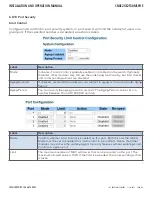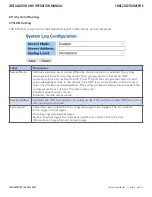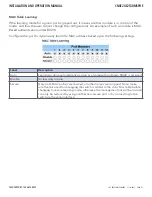
INS_CNXE2GE2TX8MSPOE 11 Jan 2021 PAGE 163
INSTALLATION AND OPERATION MANUAL
CNXE2GE2TX8MSPOE
TECH SUPPORT: 1.888.678.9427
Label
Description
Admin State (cont’d) b. Multi 802.1X
In port-based 802.1X authentication, once a supplicant is successfully
authenticated on a port, the whole port is opened for Multi 802.1X is not yet an
IEEE standard, but features many of the same characteristics as port-based 802.1X.
In Multi 802.1X, one or more supplicants can be authenticated on the same port
at the same time. Each supplicant is authenticated individually and secured in the
MAC table using the Port Security module.
In Multi 802.1X it is not possible to use the multicast BPDU MAC address as the
destination MAC address for EAPOL frames sent from the switch to the supplicant,
since that would cause all supplicants attached to the port to reply to requests sent
from the switch. Instead, the switch uses the supplicant’s MAC address, which is
obtained from the first EAPOL Start or EAPOL Response Identity frame sent by the
supplicant. An exception to this is when no supplicants are attached. In this case,
the switch sends EAPOL Request Identity frames using the BPDU multicast MAC
address as destination - to wake up any supplicants that might be on the port.
The maximum number of supplicants that can be attached to a port can be limited
using the Port Security Limit Control functionality.
MAC-based Auth.
Unlike port-based 802.1X, MAC-based authentication is not a standard, but merely
a best-practices method adopted by the industry. In MAC-based authentication,
users are called clients, and the switch acts as the supplicant on behalf of clients.
The initial frame (any kind of frame) sent by a client is snooped by the switch,
which in turn uses the client’s MAC address as both username and password in
the subsequent EAP exchange with the RADIUS server. The 6-byte MAC address
is converted to a string in the following form “xx-xx-xx-xx-xx-xx”, that is, a dash (-)
is used as separator between the lower-cased hexadecimal digits. The switch only
supports the MD5-Challenge authentication method, so the RADIUS server must
be configured accordingly.
When authentication is complete, the RADIUS server sends a success or failure
indication, which in turn causes the switch to open up or block traffic for that
particular client, using the Port Security module. Only then will frames from the
client be forwarded on the switch. There are no EAPOL frames involved in this
authentication, and therefore, MAC-based authentication has nothing to do with
the 802.1X standard.
The advantage of MAC-based authentication over port-based
802.1X is that several clients can be connected to the same port (e.g. through a 3rd
party switch or a hub) and still require individual authentication, and that the clients
don’t need special supplicant software to authenticate. The advantage of MAC-
based authentication over 802.1X-based authentication is that the clients do not
need special supplicant software to authenticate. The disadvantage is that MAC
addresses can be spoofed by malicious users - equipment whose MAC address is a
valid RADIUS user can be used by anyone. Also, only the MD5-Challenge method
is supported. The maximum number of clients that can be attached to a port can
be limited using the Port Security Limit Control functionality.
















































